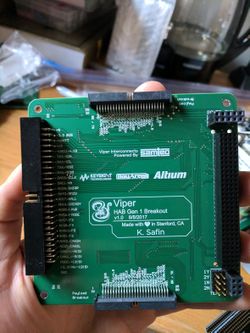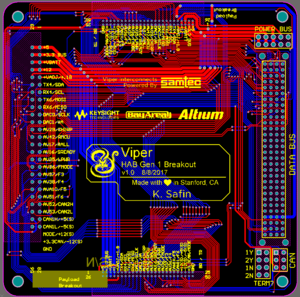Difference between revisions of "Balloons Gen 1 Breakout"
(Created page with "'''Viper''' is the first generation HONEY Breakout Board. Viper breaks out most of the important signal and power lines from the HONEY stack Data Bus & Power Bus, as well as t...") |
|||
| (16 intermediate revisions by 2 users not shown) | |||
| Line 1: | Line 1: | ||
| + | {{HONEY-sidebar | ||
| + | | header = Viper | ||
| + | | img link = File:Viper.jpg | ||
| + | | designer = Kirill Safin | ||
| + | | techline = Balloons Breakouts | ||
| + | | version = Generation I | ||
| + | | name = Viper | ||
| + | }} | ||
| + | |||
'''Viper''' is the first generation HONEY Breakout Board. Viper breaks out most of the important signal and power lines from the HONEY stack Data Bus & Power Bus, as well as the CAN Bus, to enable connecting to the HONEY flight stack remotely, over cable. | '''Viper''' is the first generation HONEY Breakout Board. Viper breaks out most of the important signal and power lines from the HONEY stack Data Bus & Power Bus, as well as the CAN Bus, to enable connecting to the HONEY flight stack remotely, over cable. | ||
| + | |||
| + | As of August 10th, 2017, all HONEY flight stacks require Viper as the bottom-most (stack-terminating) board. This makes Viper a FCC (Flight Critical Component). This is both for physical and electrical reasons -- Viper is the only board with a non-stackthrough data bus, making it the choice for the bottom-most board. This was previously the BMS, due to the need for enough space for the battery pack -- however, the maximum spacing between flight stack boards has since increased to 20mm, allowing the BMS to be on the stack interior, and necessitating an alternate stack-terminating board -- Viper was chosen. Necessarily having Viper in a Flight Stack also guarantees any stack can be debugged using the master breakout, or expanded using payload breakouts. | ||
This enables two important capabilities, such as: | This enables two important capabilities, such as: | ||
| Line 18: | Line 29: | ||
There is no need for more than two payload breakouts, with the expectation that all boards that receive the payload breakout also have a secondary connector to allow for continued daisy chaining. This is the case, for example, on ProtoBee. | There is no need for more than two payload breakouts, with the expectation that all boards that receive the payload breakout also have a secondary connector to allow for continued daisy chaining. This is the case, for example, on ProtoBee. | ||
| − | + | Details of the Venom Breakout can be found on the [[Venom_Breakout | Venom Breakout]] page. | |
| − | + | [[File: Viper2.png | right| thumb | <center> Viper Routing </center>]] | |
| − | |||
| − | In the | + | === Master Breakout === |
| + | In addition to the Venom Breakout, Viper also includes a larger, 56-pin 2.54mm (standard) pitch connector known as the Master Breakout -- or, more formally, the '''Fang Breakout'''. | ||
| − | The | + | The ''Fang Breakout'' breaks out the remainder of what the Viper Breakout was unable to breakout, or what was deemed inessential for a payload to have access to. This includes the secondary CAN Bus and some additional avionics GPIO pins. |
| − | + | [[Category:HONEY]] | |
| − | |||
| − | |||
| − | |||
| − | |||
| − | |||
| − | |||
| − | |||
| − | |||
| − | |||
| − | |||
| − | |||
| − | |||
| − | |||
| − | |||
| − | |||
| − | |||
| − | |||
| − | |||
| − | |||
| − | |||
| − | |||
| − | |||
| − | |||
| − | |||
| − | |||
| − | |||
| − | |||
| − | |||
| − | |||
| − | |||
| − | |||
| − | |||
| − | |||
| − | |||
| − | |||
| − | |||
| − | |||
| − | |||
| − | |||
| − | |||
| − | |||
| − | |||
| − | |||
| − | |||
| − | |||
| − | |||
| − | |||
| − | |||
| − | |||
| − | |||
| − | |||
| − | |||
| − | |||
Latest revision as of 21:13, 28 September 2017
| Viper | |
|---|---|
| Part of the HONEY Architecture series & the HABEES series | |

| |
| Chief Designer | Kirill Safin |
| Technology Line | Balloons Breakouts |
| Version | Generation I |
| Name | Viper |
| General | |
| HONEY Standards • Venom Breakout • Fang Breakout • Board Naming | |
| Core Software | |
| STINGR | |
| Core Avionics | |
| The Count | |
| Core Power | |
| Biscuit | |
| Core Peripherals | |
| Cobra • Viper • ProtoBee | |
| Core Radio | |
| Macaw | |
| Test & Prototype | |
| QueenBee | |
| Guides | |
| Making a HONEY Board • Using STINGR • Using QueenBee • Making a Prototype | |
| V • E | |
Viper is the first generation HONEY Breakout Board. Viper breaks out most of the important signal and power lines from the HONEY stack Data Bus & Power Bus, as well as the CAN Bus, to enable connecting to the HONEY flight stack remotely, over cable.
As of August 10th, 2017, all HONEY flight stacks require Viper as the bottom-most (stack-terminating) board. This makes Viper a FCC (Flight Critical Component). This is both for physical and electrical reasons -- Viper is the only board with a non-stackthrough data bus, making it the choice for the bottom-most board. This was previously the BMS, due to the need for enough space for the battery pack -- however, the maximum spacing between flight stack boards has since increased to 20mm, allowing the BMS to be on the stack interior, and necessitating an alternate stack-terminating board -- Viper was chosen. Necessarily having Viper in a Flight Stack also guarantees any stack can be debugged using the master breakout, or expanded using payload breakouts.
This enables two important capabilities, such as:
- The Flight Stack can be broken into two compartments, and connected seamlessly via cable, continuing to act as one complete flight stack (unless there are relevant data bus signals that aren't broken out).
- The Flight Stack can be broken out to an external payload, which, with the correct receiving connector, can have access to all of the stack data/power/signal lines. This enables using the HONEY flight stack for non-HONEY payloads -- such as ProtoBee's or similar projects.
These functions, as well as a breakdown of the Viper Breakout Pinout, are explained below:
Pinout
Viper comes with three connectors -- two "Payload Breakouts" and one "Master Breakout". They are discussed in detail below.
Payload Breakout
Viper has two Payload Breakout connectors -- this allows for the possibility of daisy chaining vertically or horizontally through the same flight stack. That is, you can "extend" the flight stack downward by having another flight stack below it, connected to the original flight stacks Viper boad, AND simultaneously extend the flight stack vertically, by adding a flight stack above the original flight stack, and connecting it to the other payload breakout.
The Payload Breakout format (meaning, the particular connector, cabling) as well as the specific pinout, is called Venom Breakout.
There is no need for more than two payload breakouts, with the expectation that all boards that receive the payload breakout also have a secondary connector to allow for continued daisy chaining. This is the case, for example, on ProtoBee.
Details of the Venom Breakout can be found on the Venom Breakout page.
Master Breakout
In addition to the Venom Breakout, Viper also includes a larger, 56-pin 2.54mm (standard) pitch connector known as the Master Breakout -- or, more formally, the Fang Breakout.
The Fang Breakout breaks out the remainder of what the Viper Breakout was unable to breakout, or what was deemed inessential for a payload to have access to. This includes the secondary CAN Bus and some additional avionics GPIO pins.
